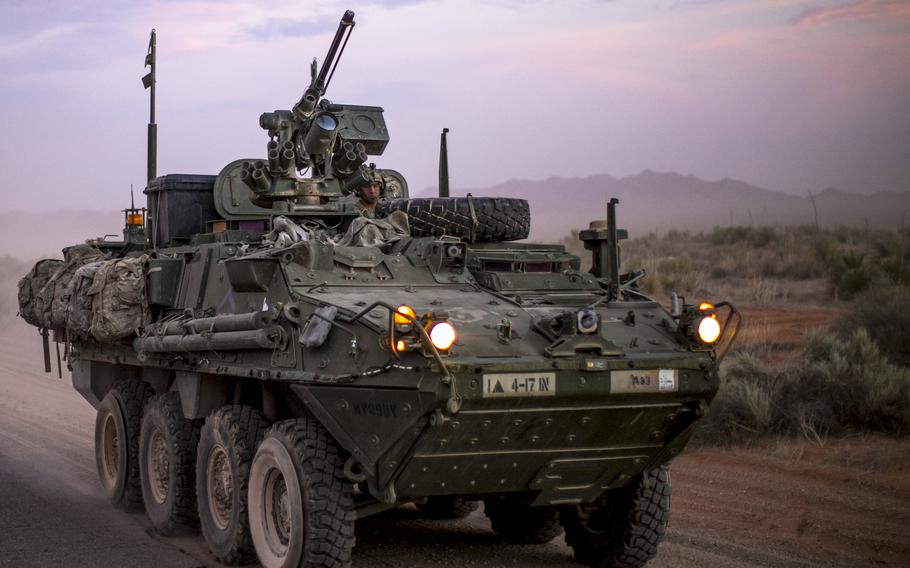
A Stryker armored personnel carrier assigned to the 1st Brigade Combat Team is driven during a field exercise. The U.S. has committed 90 Stryker personnel carriers to Ukraine. (Tin Vuong/U.S. Army)
Armed with Western weapons and trained in NATO tactics, Ukrainian troops have begun a push into Russian-occupied territory in southeastern Ukraine.
Since November, the front lines have been largely stagnant as both sides dug in for a cold winter and muddy spring. But as Russian forces have reinforced their positions, at least one factor may have tipped the state of play in Ukraine’s favor: the provision by Western allies of increasingly sophisticated, highly coveted weapons, some of which could provide serious advantages on the battlefield.
Some of those systems, however, take time and complex logistics to deliver and require lengthy training, meaning they could play more of a role in the months ahead. Here are some of the key weapons the United States has committed in the run-up to the counterattack.
Preparations for the long-awaited counteroffensive have been underway for months, with a substantial focus on consolidating Western arms and equipment, as well as completing the necessary training for operating systems new to many Ukrainian troops. This approach by the United States and Western allies goes beyond flooding the country with equipment; it emphasizes systems that complement one another on the battlefield.
The “combined arms” approach focuses on the idea that armor, infantry, aviation and other capabilities work in concert to protect and enhance one another. This is a key strategy in counteroffensives to overwhelm and exploit weaknesses and gaps in the enemy’s defenses.
With that comes the need for substantial vehicle shipments and months of training. Washington has committed 90 Stryker personnel carriers and over 100 Bradley fighting vehicles to help fulfill the combined arms strategy. The Strykers and Bradleys are generally faster, more advanced and better protected than the aging Soviet and Russian vehicles the Ukrainians operate but are more technically challenging to maintain in the field. Strykers are designed to speed infantry into battle, while Bradleys can take on other armored vehicles with their powerful cannons, but have less room for soldiers inside.
The United States has also committed to sending 31 Abrams tanks, which have better armor and advanced systems than Ukrainian tanks. Approximately 200 Ukrainian troops started a 12-week training program in Germany on the tanks in early June, so they won’t be ready for combat until early September at the earliest.
Aside from the initial assault on Kyiv and counteroffensives in the east and south last year, the war in Ukraine has been mostly defined by static trench warfare and distant artillery exchanges.
Counteroffensive operations are much more fluid and up close. To succeed, Ukrainian troops have to move fast to take territory from Russians, putting them much closer to enemy lines.
The United States has provided weapons with a range of less than three miles for these operations, including 4,000 TOW missiles. These missiles can either be set up on a heavy tripod or on a Humvee, allowing troops to fire them and quickly depart, to avoid having the enemy strike their position — a technique known as “shoot and scoot.”
The United States has also sent Ukraine 105mm artillery pieces, which trade power and range for ease of transport, making them simpler to move around a shifting battlefield compared with heavier howitzers such as the M777. Other weapons including a trio of anti-armor systems — Javelins, AT4s and Carl Gustaf recoilless rifles — are meant for infantry soldiers to attack vehicles on foot.
Successful counteroffensive operations require movement through territory enemy soldiers have already primed with physical barriers and minefields, designed to slow down advancing troops and channel them into places they are most vulnerable.
According to Mark Cancian, a senior adviser with the Center for Strategic and International Studies, the solution is rushing anti-mine equipment and explosives into the country. The United States has sent Ukraine bomb-resistant vehicles known as MRAPs with mine rollers attached to the front, designed to detonate mines before they can strike the vehicle itself. It has also delivered protective gear and explosives that will help bomb technicians and engineers gather and destroy obstacles and hazards.
Noncombat vehicles that Ukraine has received are also crucial, Cancian said. Fuel trucks help keep gas-hungry vehicles from running dry, and transport trucks hauling vehicles including tanks to the front help reduce wear and tear on their tracks. Fleets of recovery trucks also help haul destroyed and damaged vehicles for repair to get back into the fight.
Weapons such as long-range artillery play an important support role in counteroffensives, Cancian said, by attacking reserves units trying to reach areas of attack.
“The classic situation is you attack a defensive line, they hold you up for a little while, but then they have to rush in reinforcements from other areas,” he said. “And if they can get those in, then they can bog you down, maybe keep you from breaking through, or limit your breakthrough.”
By using longer-range weapons, the attackers “can isolate the battlefield so the other side can’t bring in any reinforcements.”
Those weapons can also prevent logistics troops from resupplying the defenders, Cancian said.
While the United States has provided HIMARS vehicles that can fire rockets about 50 miles away and some systems that can double that reach, it has denied long-standing Ukrainian requests for missiles that can travel nearly 200 miles, limiting the options for commanders to strike distant targets.
Artur Galocha contributed to this report.